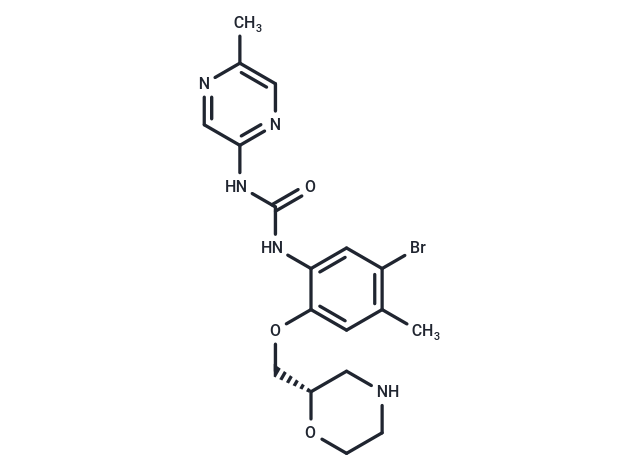Shopping Cart
Remove All Your shopping cart is currently empty
Your shopping cart is currently empty
Rabusertib (IC-83) is an inhibitor of the cell cycle checkpoint kinase 1 (chk1) with potential chemopotentiating activity. Rabusertib has been used in trials studying the treatment of Cancer, Solid Tumors, Advanced Cancer, Pancreatic Neoplasms, and Non-Small Cell Lung Cancer.

| Pack Size | Price | USA Warehouse | Global Warehouse | Quantity |
|---|---|---|---|---|
| 5 mg | $38 | In Stock | In Stock | |
| 10 mg | $59 | In Stock | In Stock | |
| 25 mg | $119 | In Stock | In Stock | |
| 50 mg | $179 | In Stock | In Stock | |
| 100 mg | $272 | In Stock | In Stock | |
| 200 mg | $396 | In Stock | In Stock | |
| 1 mL x 10 mM (in DMSO) | $42 | In Stock | In Stock |
| Description | Rabusertib (IC-83) is an inhibitor of the cell cycle checkpoint kinase 1 (chk1) with potential chemopotentiating activity. Rabusertib has been used in trials studying the treatment of Cancer, Solid Tumors, Advanced Cancer, Pancreatic Neoplasms, and Non-Small Cell Lung Cancer. |
| Targets&IC50 | NTRK1:12000 nM, CaMK II:1550 nM, RSK2:5700 nM, PDK1:893 nM, JNK1:4930 nM, Chk2:12000 nM, VEGFR3:2128 nM, MET:2200 nM, Chk1:7 nM |
| In vitro | Chk1 is an ATP-dependent serine-threonine kinase and a key component in the DNA replication-monitoring checkpoint system activated by double-stranded breaks (DSBs). Chk1 contributes to all currently defined cell cycle checkpoints, including G1/S, intra-S-phase, G2/M, and the mitotic spindle checkpoint. By inhibiting the activity of chk1, Rabusertib prevents the repair of DNA caused by DNA-damaging agents, thus potentiating the antitumor efficacies of various chemotherapeutic agents. However, preClinicalal data involving Rabusertib has not been published until now. [1] Inhibition of Chk1 is predicted to enhance the effects of antimetabolites, such as gemcitabine. [2] Rabusertib treatment impairs DNA synthesis, increases DNA damage (via mitotic defects), induces apoptosis, and has synergistic activity with pemetrexed, especially in p53 mutant tumor cells. [3] |
| In vivo | In xenograft models, LY2603618 delays tumor growth when given in combination with pemetrexed. [3] |
| Kinase Assay | Protein kinase assays are performed variously. Assays are performed on the following protein kinases: ABL, AKT1, ARG, CAMK2, CDK1, CDK2, CHK1, CHK2, DAPK1, EGFR, EPHA1, EPHB2, EPHB3, EPHB4, ERK1, ERK2, FES, FGFR1, FGFR3, FGFR4, FGR, HCK, HER2, INSR, JNK1, JNK2, LCK, MET, NTRK1, NTRK2, p38α, p38β, p38δ, p38γ, p70S6K, PDGFRα, PDGFRβ, PDK1, PKCα, ROCK2, ROS, RSK2, SGK1, SRC, SYK, TAK1, TYRO3, VEGFR2, VEGFR3, YES, ZAP70[1]. |
| Cell Research | LY2603618 is prepared in DMSO (10 mM) and stock, and then diluted 1000-fold into medium[1]. Cells are plated at 2.5×103 per well, on 96-well tissue culture plates and incubated for one cell doubling (18-24 h). Gemcitabine dilutions are set up by half-log steps across a final concentration range of 1-1000 nM. LY2603618 is prepared by dilutions in DMSO to 5000× final concentration, and then diluted 1000-fold into medium to generate 5× stocks for addition to wells. Approximately 24 h after Gemcitabine addition, LY2603618 is added. Each combination is done in triplicate. After a period of two cell doublings following LY2603618 addition, MTS/PMS reagent is added to each well according to the manufacturer's instructions. Absorbance is read on a Spectra Max 250 spectrophotometer at 490 nm and the data analyzed with GraphPad Prism 4.0. Dose-response curves are fit by non-linear regression, with bottom fits constrained to 0 % inhibition[1]. |
| Synonyms | LY2603618, IC-83 |
| Molecular Weight | 436.3 |
| Formula | C18H22BrN5O3 |
| Cas No. | 911222-45-2 |
| Smiles | Cc1cnc(NC(=O)Nc2cc(Br)c(C)cc2OC[C@@H]2CNCCO2)cn1 |
| Relative Density. | 1.461 g/cm3 |
| Color | White |
| Appearance | Solid |
| Storage | Powder: -20°C for 3 years | In solvent: -80°C for 1 year | Shipping with blue ice/Shipping at ambient temperature. | ||||||||||||||||||||||||||||||
| Solubility Information | DMSO: 40 mg/mL (91.68 mM), Sonication is recommended. H2O: < 1 mg/mL (insoluble or slightly soluble) Ethanol: < 1 mg/mL (insoluble or slightly soluble) | ||||||||||||||||||||||||||||||
| In Vivo Formulation | 10% DMSO+40% PEG300+5% Tween 80+45% Saline: 1 mg/mL (2.29 mM), Sonication is recommended. Please add the solvents sequentially, clarifying the solution as much as possible before adding the next one. Dissolve by heating and/or sonication if necessary. Working solution is recommended to be prepared and used immediately. The formulation provided above is for reference purposes only. In vivo formulations may vary and should be modified based on specific experimental conditions. | ||||||||||||||||||||||||||||||
Solution Preparation Table | |||||||||||||||||||||||||||||||
DMSO
| |||||||||||||||||||||||||||||||
| Size | Quantity | Unit Price | Amount | Operation |
|---|

Copyright © 2015-2025 TargetMol Chemicals Inc. All Rights Reserved.